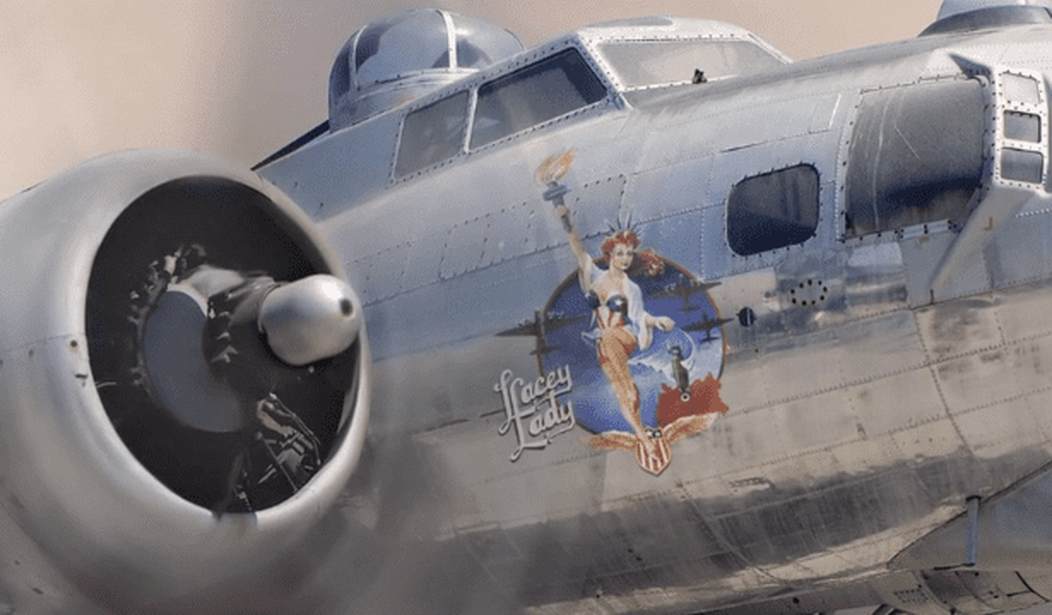The journey began in 1948, when Art Lacey purchased from the War Assets Administration a surplus 1945-vintage Boeing B-17G bomber that was sitting in a field at Altus Air Base in Oklahoma. His plan: to fly the bomber west and place it atop his family’s service station on McLoughlin Blvd. in Milwaukie, Oregon—a combination canopy and roadside attraction.
Three years into the post-war era, some surviving B-17s had been repurposed for patrol and air-sea rescue work, but most were destined for the scrap-heap. The last of them was withdrawn from service in 1959.
The story behind Lacey’s acquisition is worth telling. Lacey was a pilot, but after shelling out $13,750.00, for an operative “Flying Fortress,” he crashed it. The administrators at Altus apparently sympathized with his bad luck, and sold him a second one for $1,500.00.
The aircraft Lacey purchased had never seen service, and was in near-pristine condition. Thereafter, for 68 years, the “showroom” example of the warplane that wreaked havoc on the Axis powers in World War II flew over the station’s pumps, a can’t-miss sight along the busy arterial.
In 2015, with Oregon weather and public tours (fill your tank, get a tour) having taken their toll, it was decided by the family that the bomber would be removed from the gas station, installed in a hangar, and fully restored to flight capability. A home for the renamed “Lacey Lady” was found at historic McNary Field in Salem. Thanks to a remarkable nonprofit restoration effort, there she sits today, well on her way, to being airworthy again.
Art Lacey’s grandson, Jayson Scott, president and CEO of the B-17 Alliance Foundation, offers an inside look at the challenges facing the restoration team.
“All phases of the restoration must be performed to exacting standards,” says Scott, “and many parts and materials that came off the line in the 1940s will have to be recreated from scratch.”
Since arriving in Salem, the Alliance restoration team has grown from ten original volunteers to over 120 “crew” members who have donated thousands of hours to the project.
It has been an exhaustive process. One of the first tasks was to remodel the hanger and create a restoration shop complete with shelving and tables to inventory and work on parts disassembled from the plane. Equipment for the restoration was acquired, either by donation or purchased outright, including a 10-foot metal shear, an industrial-capacity sheet metal brake, saws, sanders, rivet guns, a crane and a forklift.
In preparation for the actual restoration work, the crews created massive steel structures called “jigs” to stabilize the plane and protect both the plane and restoration personnel.
Crew members must examine every part and list what’s good and what cannot be reused. Reusable parts must be cleaned, chemically treated, and tested, among other processes. Original parts must also undergo something called “non-destructive testing,” to make sure they can withstand the rigors of flight. This process utilizes x-ray and ultrasound to check for corrosion and determine structural strength, and eliminates the need to fully disassemble the parts.
Damaged or missing parts (some touring customers were not above snatching random parts as souvenirs) must be fabricated or custom-built to original specifications. New parts are made of a type of malleable aluminum metal, trimmed, fitted, and painted.
The crew members have formed into three teams, each tackling a different section of the plane. The Wing One team has taken on the massive 7000-pound inboard portion of the number one wing, which took nearly a year to disassemble. Good news came when it was determined that 80-85% of this section’s component parts are in remarkably good condition, and reusable.
The forward fuselage team is focusing on wrapping up a near-complete bombardier/navigators’ section, after which they will progress into the cockpit area. Finally, the aft fuselage team will be building a tail-gunner’s position nearly from scratch. The section was substantively damaged by an errant milk truck delivery driver when the bomber was over the gas station.
From there, the project workers will begin work on the main fuselage and bomb bay sections, which Scott says will require significant restoration.
One talented team member, skilled machinist Charlie Miller, built 13 replica machine guns for the Lacey Lady’s gun ports. Former NASA project manager David Neuner got involved, leading a team of IT specialists to develop an internal inventory system for storage and retrieval of each and every part removed from the aircraft.
After learning of the restoration project, original B-17 designers and builders Boeing Corp stepped up to the plate, supplying a full set of blueprints and many rare parts remaining from a previous B-17 restoration.
From the Alliance Foundation website:
The Lacey Lady is the most intact wartime B-17 Flying Fortress in the world under restoration today, and holds the lowest amount of engine hours of any B-17 still in existence. Fewer than 50 B-17 Flying Fortresses survive in the world today, all in different stages of repair, as war inventory was parted out and melted down decades ago. The Lacey Lady is one of the last fully intact bombers that can be restored.
Terry Scott, Jayson’s wife and executive director of the foundation, adds this to Jayson’s detailed restoration information. “This is much more than the restoration of a rare aircraft. We have grown into a complex corporation. Veteran outreach, student education, public tours, and the creation of an extensive WWII & Aviation Research library have become integral parts of the mission and vision. Our following has more than quadrupled since opening our facility at Salem Airport.”
The restoration of this historic aircraft is an expensive proposition. The Scott family has spent just over $500,000 of its own money so far, and Terry estimates that another $500,000 has come in from donations and sponsored events. Jayson projects that the grand total to see the Lacey Lady airborne again could come in at $6 million dollars.
“We welcome donations to our foundation,” he says. “We are strong stewards of our money. The plan is to proceed on a cash basis, accruing zero debt to make this happen.”
When it does happen, which at the current rate of restoration and funding Scott estimates will occur in 2035, a beautifully restored example of the most iconic bomber of the Second World War will take flight.









Join the conversation as a VIP Member